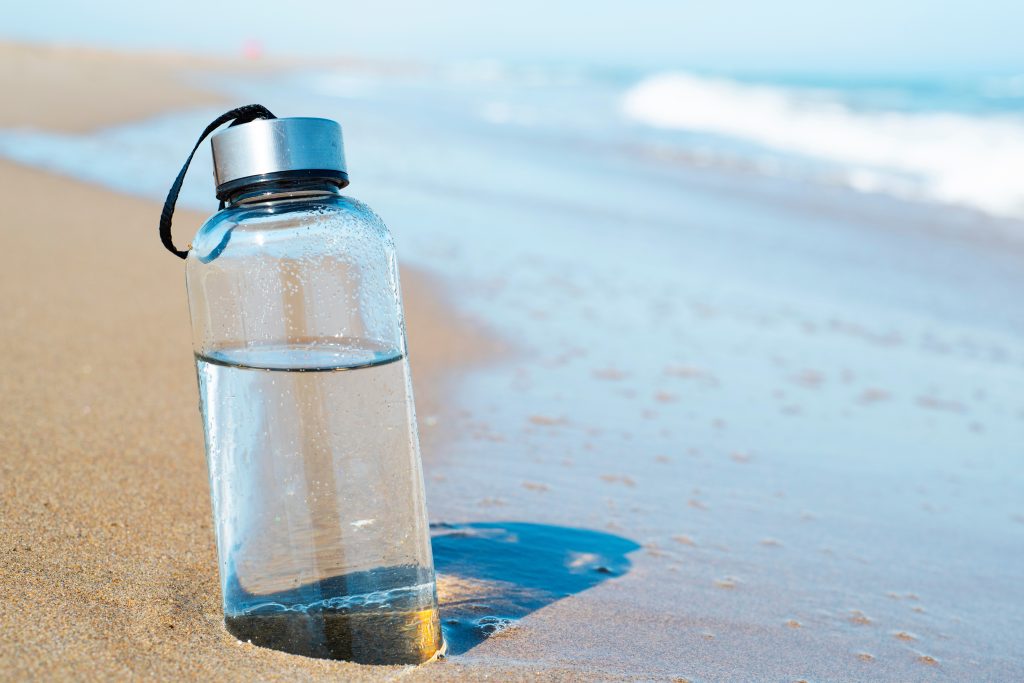Stanley Cups Contain Lead – Should You Be Worried?
It was just revealed that Stanley cups contain lead. Should you be worried or should you keep adding to your Stanley cup collection? Just like the Beanie Baby craze that came before it, the Stanley cup obsession is defying consumer logic. In a race to collect all the Stanley cups, thousands of dollars are being “invested”, people are being assaulted, and stores are being robbed. Check out these videos if you want to get caught up on the Stanley cup saga.
Stanley Cups Contain Lead
Before you start planning a Stanley cup heist that makes the movie Italian Job look like an amateur operation, realize that Stanley cups contain lead. Yes lead, the heavy metal neurotoxin that was placed in gasoline to increase its octane, in paint to reduce flaking, and in water pipes to reduce corrosion.1
In all cases, placing lead in consumer products has been an absolute disaster. Leaded gasoline alone is responsible for collectively reducing the IQ of Americans by 824 million points. Lead toxicity is also linked with a wide range of health problems including reproductive and cardiovascular issues.2 3
Why Do Stanley Cups Contain Lead?
According to Stanley, they use a lead pellet in their production process to aid in the insulation of beverages. They placed a stainless steel covering over the lead to ensure that no lead contamination occurs unless the barrier is removed, which according to them, is possible, but a rare occurrence.4
By the looks of it, they also use the lead as a stabilization weight, to ensure that Stanley cups don’t fall over due to their small, but convenient cup holder-sized bottoms.
Stanley says they are taking steps to find alternative materials for their sealing process and are currently working on implementing these innovations in their manufacturing process.
Symptoms Of Lead Poisoning
Lead poisoning has detrimental effects on both physical and mental health, particularly for children as their bodies are still developing. Lead poisoning can happen gradually with repeated exposure to small amounts of lead, or it can occur suddenly after being exposed to a large amount of lead.
Symptoms of lead poisoning vary depending on the individual and the level of exposure. Lead causes damage to the stomach and intestines, leading to abdominal pain. Lead slows down the digestive system, causing constipation. Lead disrupts the production of red blood cells, resulting in fatigue and weakness.
Lead exposure has been linked to headaches, particularly migraines. Children with lead poisoning may exhibit irritability, mood swings, and decreased attention span. Lead often suppresses the appetite, leading to weight loss and malnutrition.
Lead poisoning in children causes damage to blood vessels and increases their risk of developing hypertension at an early age. This has long-term consequences on their health as they grow older.
Lead affects brain function, leading to memory loss and difficulty concentrating. High levels of lead damages nerves, causing numbness or tingling in the hands and feet. In severe cases of lead poisoning, seizures may occur.
If left untreated, lead poisoning leads to serious complications such as kidney damage, nerve damage, anemia, and even death. This is why it’s crucial to identify and treat lead poisoning as early as possible.5

Lead Poisoning And Autoimmune Conditions
Lead poisoning has been linked to the development of autoimmune conditions. An autoimmune condition is a disorder in which the immune system attacks healthy cells and tissues in the body, causing inflammation and damage.
Lead disrupts the normal function of the immune system, making it more likely to attack the body’s own cells. Studies have shown that individuals with higher levels of lead in their blood are more likely to have certain autoimmune conditions such as rheumatoid arthritis.6
It is also important to note that lead poisoning may trigger or worsen existing autoimmune conditions. This is because lead exposure causes chronic inflammation and oxidative stress, which are known triggers for autoimmune responses.7
Read more about what causes autoimmune conditions.
Lead Poisoning And Cardiovascular Diseases
Lead damages blood vessels by increasing oxidative stress and inflammation, leading to atherosclerosis, which is a major risk factor for heart disease. Lead has also been found to disrupt the production and function of red blood cells, leading to anemia. Anemia reduces oxygen levels in the blood, putting extra strain on the heart.
In addition, lead also alters the function of the autonomic nervous system, which regulates heart rate and blood pressure. This contributes to hypertension, a major risk factor for cardiovascular diseases, and it often leads to heart attacks, strokes, and other serious complications.8
Moreover, lead exposure during pregnancy has detrimental effects on the developing cardiovascular system of the fetus. Studies have shown that mothers with high levels of lead in their blood are more likely to have children with congenital heart defects.9
Read more about lead toxicity.
Lead Poisoning And Endocrine Conditions
Research has shown that exposure to lead disrupts the proper functioning of the endocrine system. Lead acts as an endocrine disruptor, meaning it interferes with hormone production and regulation. This disruption leads to a variety of health issues, including abnormalities in hormone levels, metabolism, and reproductive health.
Thyroid disorders are prevalent among individuals with lead exposure. Lead interferes with the production of thyroid hormones, which play a crucial role in regulating metabolism and energy levels. This disruption often leads to hypothyroidism or an underactive thyroid, causing symptoms such as fatigue, weight gain, and depression.10
In addition to thyroid disorders, lead exposure has also been linked to polycystic ovary syndrome (PCOS). PCOS is a common hormonal disorder among women of reproductive age, characterized by irregular periods, excess hair growth, and fertility issues.11
Read more about PCOS.
Detoxing Lead From The Body
The only solution to dealing with lead toxicity is to remove it from the body. Removing heavy metals from the body requires patience, but is the only way to receive lasting relief from heavy metal-induced health problems.
Oral chelation therapy is used to detoxify the body from harmful heavy metals, like lead and mercury. Chelation therapy works by binding to the lead molecules in the body and removing them through urine excretion. This process helps to reduce the overall levels of lead in the body and mitigate its harmful effects. While traditional chelation therapy is administered intravenously, oral chelation therapy offers a less invasive and more convenient option.
One of the key benefits of oral chelation therapy is that it can be easily done at home without the need for hospital visits or medical supervision. This makes it a more affordable and accessible treatment option.12
Read more about removing heavy metals from the body.
Are Stainless Steel Cups A Healthy Option?
Stanley and their competitors make their cups out of stainless steel. One of the main advantages of stainless steel is its durability. It is resistant to corrosion, rust, and stains, making it a long-lasting option for drinking vessels. Even though the industry consensus is that stainless steel is non-toxic, that is not entirely true, as it has the potential to leach harmful chemicals into drinks.
Recent studies have shown that stainless steel may not be as safe as previously thought. When exposed to high heat or acidic foods, stainless steel can leach nickel and chromium into the food being cooked.13 Additionally, it was found that chromium and nickel from stainless steel leached into acidic fruit juice. Fortunately, stainless steel did not leach metals into distilled water with a pH of 7.14
Nickel is a known allergen and exposure to it has been linked to respiratory disorders and kidney problems.15 Chromium, on the other hand, can accumulate in the body over time and cause respiratory issues, skin irritation, and even liver damage.16
If you are going to use a stainless steel cup, avoid filling it with anything acidic or alkaline.
Are Plastic Bottles A Better Option?
No, plastic bottles are made from a material called polyethylene terephthalate (PET). This type of plastic has been found to leach endocrine disrupting chemicals into the liquid it holds, particularly when exposed to heat or sunlight.17
Additionally, a recent study found that the liquid held inside plastic bottles contain hundreds of thousands of micro-nano sized plastic particles.18 When we drink from these bottles, these plastic particles pass directly through our intestines and accumulate in our organs.19
Healthy Drinking Bottles – Glass
Glass is king when it comes to the best material for drinking bottles. First and foremost, glass is a non-porous material, meaning it does not allow any air or liquids to pass through its surface. This makes it easy to clean and prevents any bacteria or germs from being trapped in the vessel. Additionally, glass is also chemical-free and does not release any harmful toxins when in contact with liquids. This makes it a safe and healthy option for drinking bottles.
Moreover, glass is also environmentally friendly as it is recyclable and does not produce any toxic by-products during the manufacturing process. It also maintains the taste and purity of the beverages, unlike other materials that may affect the flavor of drinks. Furthermore, glass does not retain any odors or flavors, making it ideal for use with different types of beverages. Glass has one obvious downfall, as it breaks easily. However, from a health perspective, drinking out of glass is ideal.20

Stanley Cups Contain Lead – Should You Be Worried?
There are no safe levels of lead exposure. So while the risk of lead exposure from Stanley cups is low, if the cup is fully intact, the potential for lead poisoning is still present. Additionally, the potential for lead dust accumulation on all surfaces of the cup during the manufacturing process is also a possibility. Lead, combined with the potential dangers of drinking out of stainless steel, leave only one really decent solution, reusable glass drinking bottles.
In any case, whatever cup you choose, don’t fill it with tap water if you value your health.
Read all about the toxins in tap water.
References
1 Dignam T, Kaufmann RB, LeStourgeon L, Brown MJ. Control of Lead Sources in the United States, 1970-2017: Public Health Progress and Current Challenges to Eliminating Lead Exposure. J Public Health Manag Pract. 2019 Jan/Feb;25 Suppl 1, Lead Poisoning Prevention(Suppl 1 LEAD POISONING PREVENTION):S13-S22. doi: 10.1097/PHH.0000000000000889. PMID: 30507765; PMCID: PMC6522252.
2 Lead exposure in last century shrank IQ scores of half of Americans | Duke Today. (2022, March 7). Duke Today. https://today.duke.edu/2022/03/lead-exposure-last-century-shrunk-iq-scores-half-americans
3 National Research Council (US) Committee on Measuring Lead in Critical Populations. Measuring Lead Exposure in Infants, Children, and Other Sensitive Populations. Washington (DC): National Academies Press (US); 1993. 2, Adverse Health Effects of Exposure to Lead. Available from: https://www.ncbi.nlm.nih.gov/books/NBK236465/
4 Do Stanley cups contain lead or pose a risk of lead poisoning? Experts weigh in. (2024, January 27). TODAY.com. https://www.today.com/health/news/stanley-cups-lead-rcna135513
5 Olufemi AC, Mji A, Mukhola MS. Potential Health Risks of Lead Exposure from Early Life through Later Life: Implications for Public Health Education. Int J Environ Res Public Health. 2022 Nov 30;19(23):16006. doi: 10.3390/ijerph192316006. PMID: 36498077; PMCID: PMC9741093.
6 Irfan S, Rani A, Riaz N, Arshad M, Kashif Nawaz S. Comparative Evaluation of Heavy Metals in Patients with Rheumatoid Arthritis and Healthy Control in Pakistani Population. Iran J Public Health. 2017 May;46(5):626-633. PMID: 28560193; PMCID: PMC5442275.
7 Cojocaru M, Chicoş B. The role of heavy metals in autoimmunity. Rom J Intern Med. 2014;52(3):189-91. PMID: 25509564.
8 Park Y, Han J. Blood Lead Levels and Cardiovascular Disease Risk: Results from the Korean National Health and Nutrition Examination Survey. Int J Environ Res Public Health. 2021 Sep 30;18(19):10315. doi: 10.3390/ijerph181910315. PMID: 34639615; PMCID: PMC8508187.
9 Wang C, Pi X, Yin S, Liu M, Tian T, Jin L, Liu J, Li Z, Wang L, Yuan Z, Wang Y, Ren A. Maternal exposure to heavy metals and risk for severe congenital heart defects in offspring. Environ Res. 2022 Sep;212(Pt C):113432. doi: 10.1016/j.envres.2022.113432. Epub 2022 May 6. PMID: 35533713.
10 Javorac D, Baralić K, Marić Đ, Mandić-Rajčević S, Đukić-Ćosić D, Bulat Z, Djordjevic AB. Exploring the endocrine disrupting potential of lead through benchmark modelling – Study in humans. Environ Pollut. 2023 Jan 1;316(Pt 1):120428. doi: 10.1016/j.envpol.2022.120428. Epub 2022 Oct 13. PMID: 36244500.
11 Kirmizi DA, Baser E, Turksoy VA, Kara M, Yalvac ES, Gocmen AY. Are Heavy Metal Exposure and Trace Element Levels Related to Metabolic and Endocrine Problems in Polycystic Ovary Syndrome? Biol Trace Elem Res. 2020 Nov;198(1):77-86. doi: 10.1007/s12011-020-02220-w. Epub 2020 Jun 5. Erratum in: Biol Trace Elem Res. 2021 Sep;199(9):3570. PMID: 32504400.
12 Sears ME. Chelation: harnessing and enhancing heavy metal detoxification–a review. ScientificWorldJournal. 2013 Apr 18;2013:219840. doi: 10.1155/2013/219840. PMID: 23690738; PMCID: PMC3654245.
13 Kamerud KL, Hobbie KA, Anderson KA. Stainless steel leaches nickel and chromium into foods during cooking. J Agric Food Chem. 2013 Oct 2;61(39):9495-501. doi: 10.1021/jf402400v. Epub 2013 Sep 19. PMID: 23984718; PMCID: PMC4284091.
14 Bassioni, G., Korin, A., & El-Din Salama, A. (2014, December 26). Stainless steel as a source of potential hazard due to metal leaching … International Journal of ELECTROCHEMICAL SCIENCE. http://electrochemsci.org/papers/vol10/100503792.pdf
15 Genchi G, Carocci A, Lauria G, Sinicropi MS, Catalano A. Nickel: Human Health and Environmental Toxicology. Int J Environ Res Public Health. 2020 Jan 21;17(3):679. doi: 10.3390/ijerph17030679. PMID: 31973020; PMCID: PMC7037090.
16 Reif BM, Murray BP. Chromium Toxicity. [Updated 2024 Jan 11]. In: StatPearls [Internet]. Treasure Island (FL): StatPearls Publishing; 2024 Jan-. Available from: https://www.ncbi.nlm.nih.gov/books/NBK599502/
17 Sax L. Polyethylene terephthalate may yield endocrine disruptors. Environ Health Perspect. 2010 Apr;118(4):445-8. doi: 10.1289/ehp.0901253. PMID: 20368129; PMCID: PMC2854718.
18 Qian N, Gao X, Lang X, Deng H, Bratu T, Chen Q, Stapleton P, Yan B, Min W. (2024, January 8). Rapid single-particle chemical imaging of nanoplastics by SRS microscopy. https://www.pnas.org/doi/10.1073/pnas.2300582121
19 Goodman KE, Hua T, Sang QA. Effects of Polystyrene Microplastics on Human Kidney and Liver Cell Morphology, Cellular Proliferation, and Metabolism. ACS Omega. 2022 Sep 19;7(38):34136-34153. doi: 10.1021/acsomega.2c03453. PMID: 36188270; PMCID: PMC9520709.
20 Ibrahim ID, Hamam Y, Sadiku ER, Ndambuki JM, Kupolati WK, Jamiru T, Eze AA, Snyman J. Need for Sustainable Packaging: An Overview. Polymers (Basel). 2022 Oct 20;14(20):4430. doi: 10.3390/polym14204430. PMID: 36298009; PMCID: PMC9609329.




